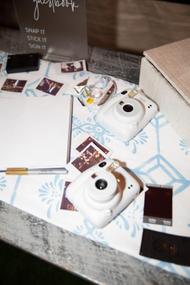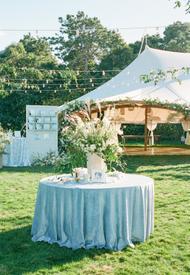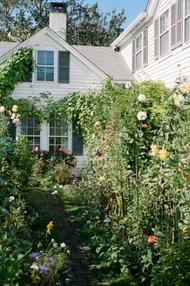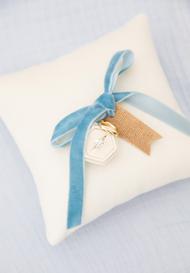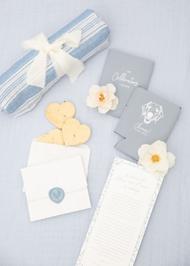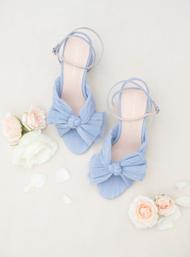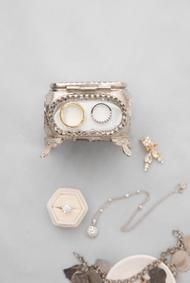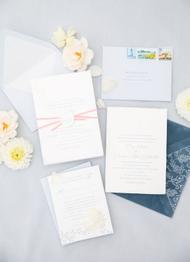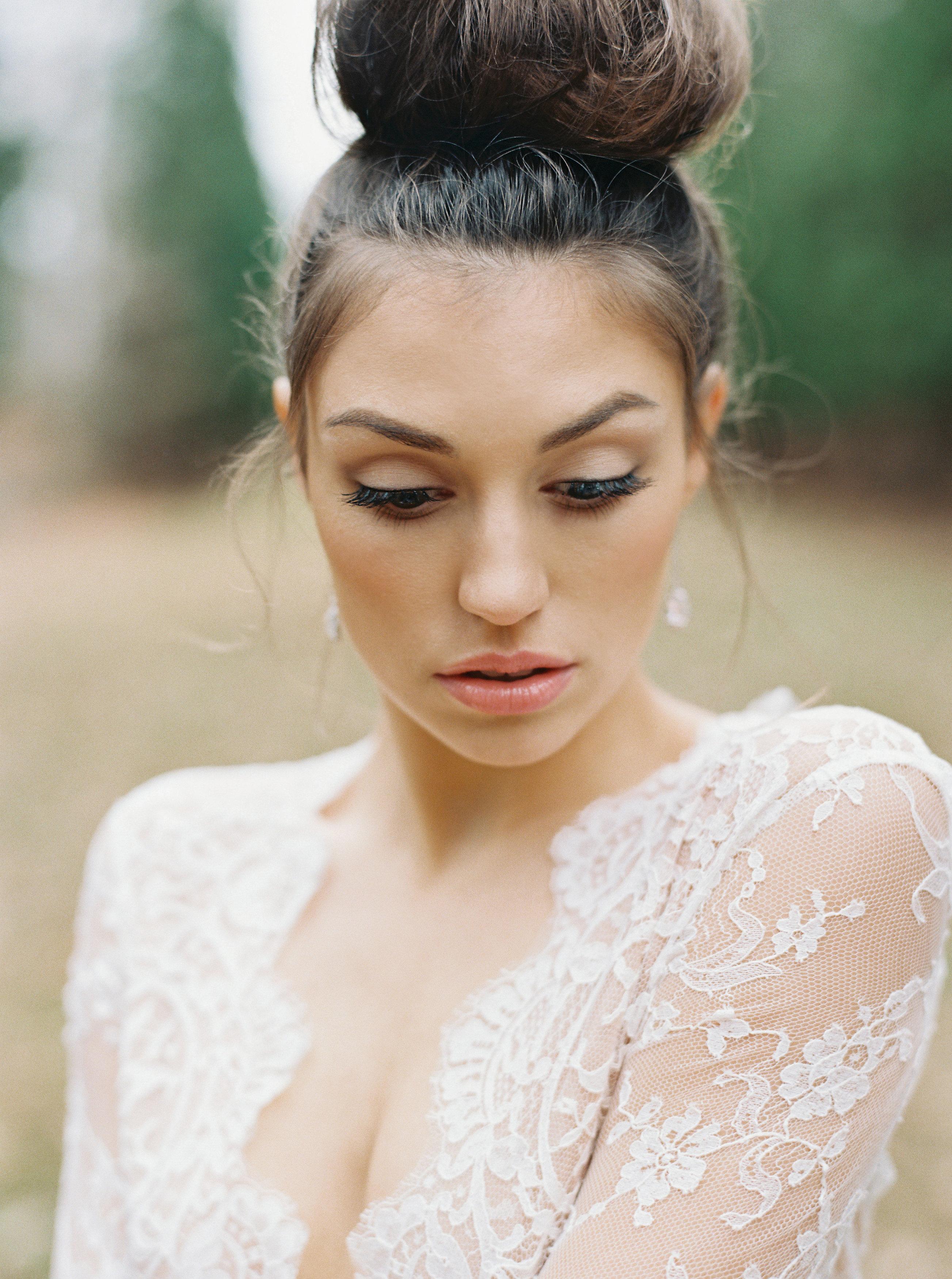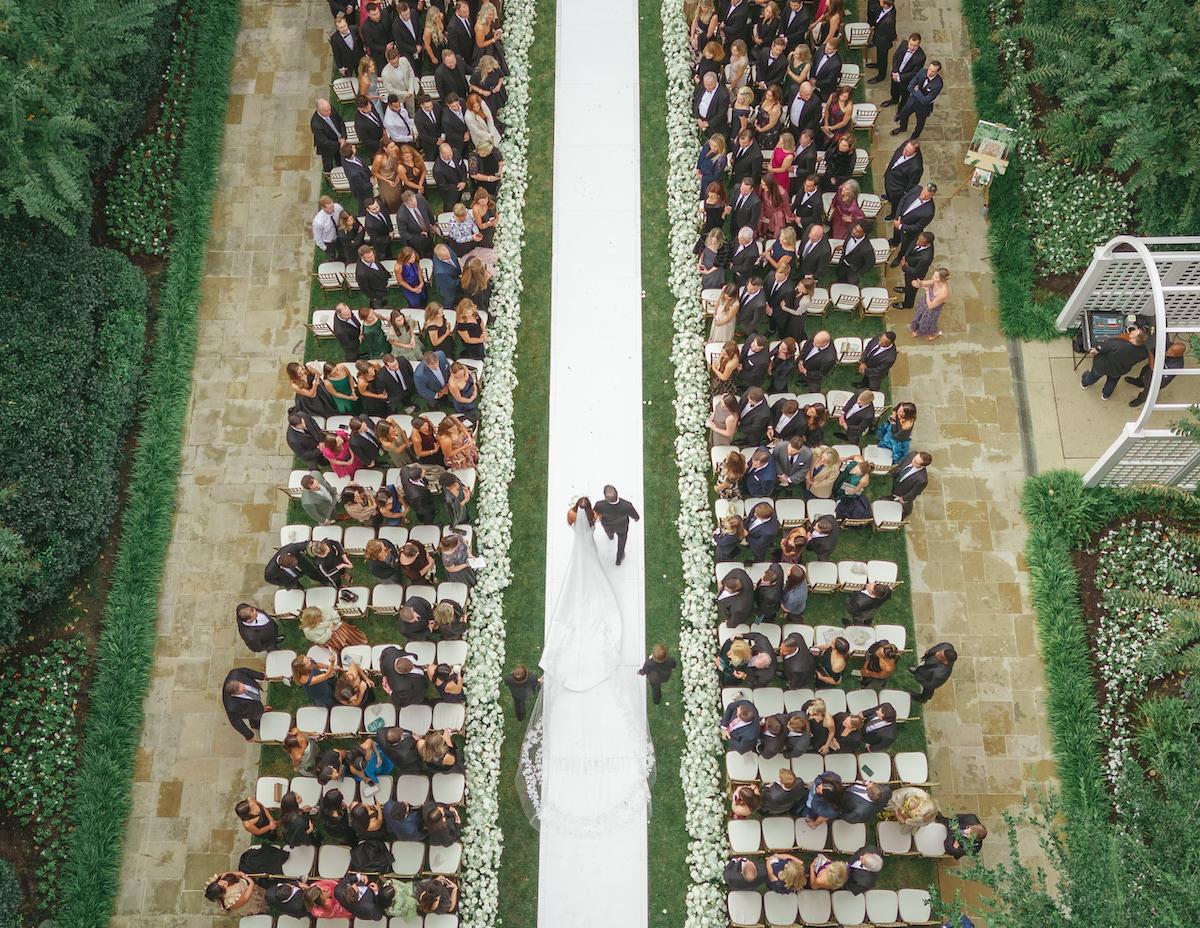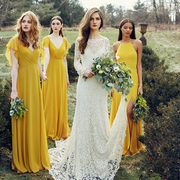[section title=”The Planning”]
[field title=”Wedding Colors”]Their colors were primarily sage and white, with touches of gold. They included some blush and light pink tones for the bridesmaids dresses to showcase each lady’s individual beauty and to embrace the overall vision.[/field]
[field title=”Design / Vibe / Vision”]
Once the venue was set, the vision of the wedding sparked from the idea of a modern garden party with nods to Jane Austen’s romances and the glamor of the 1920s. Embracing approachable elegance, Lindsey and Matthew wanted their guests to enjoy the intimacy of a smaller celebration while having an excuse to break out their formal wear. They are people who thoroughly love any excuse to dress up and celebrate their loved ones! Lindsay truly enjoyed every minute of planning and bringing this celebration to life.
[/field]
[field title=”Proposal Story”]
Unknown to Lindsay, Matt had this vision of proposing once they owned a home together. He felt that the front porch where they would build their life wasn’t just fitting symbolically but reflected the nature of their relationship: easy and comfortable. A week or so before he proposed, Matt told Lindsay he wanted to go to brunch on Christmas Eve to have some time to celebrate the season as a couple. The morning of, she was running behind while Matt was the picture of serenity and even told her he was able to push the brunch reservation back to give her more time to get ready. Later she would find out that he had budgeted extra time just in case one of them took longer to get ready. Usually, Lindsay’s hair or their dogs needing to go out was the culprit of the couple’s tardiness. Once she was finally ready, Lindsay came downstairs to see Matt on the front porch swing, with his music speaker out as he so often did. She stepped outside, and Matt was extra sweet, telling her that she looked pretty and he wanted to take her picture. So Matt poses his sweetheart in front of their door, and goes down the front steps to take the picture. Lindsay is all smiles and thinking how lucky she is to have a partner who works to make her feel special … and then their song starts to play, and he’s walking up the steps pulling the ring out of his pocket once he reaches the landing. He proposes short and sweet with the classic “Will you make me the happiest man and marry me?” Too elated to remember clearly, Lindsay is pretty sure she responded with yes, and I love you, but the exact memory is a blur of joy. Later that day, the couple got to celebrate with her family, and the next day they celebrated with his family. After close to six years of being together, everyone was delighted for the pair to cement the next chapter of their story.
[/field]
[/section]
[board_carousel title=”Getting Ready”]
[/board_carousel]
[board_carousel title=”Bridal Portraits”]
[/board_carousel]
[board_carousel title=”Flat Lays”]
[/board_carousel]
[board_carousel title=”First Look”]
[/board_carousel]
[section title=”The Fashion”]
[field title=”Wedding Gown”]
Lindsay purchased her wedding gown from Duchess Bridal Boutique in Greensboro, North Carolina, owned by the sweetest couple devoted to celebrating every couple’s love story. It was actually the first dress she tried on! She fell in love with the classic elegance of the dress, the effortless movement of the skirt, and the pockets. Originally the Eddy K gown had a long train and a short band-like off-the-shoulder sleeve, but Lindsay decided to cut off the train to make the longer puff sleeves that gave her the Austen romance touch she loves. For her reception dress, Lindsay was beyond fortunate to work with the talented and vivacious Cassidy of CassB By Design to have a custom gown made to dance the night away in. Lindsay feels she couldn’t have asked for better bridal experiences than being a client of these two amazing vendors. Both Witneigh of Duchess Bridal Boutique and Cassidy of CassB Designs are the most genuine souls and wonderful cheerleaders for their clients.
[/field]
[field title=”Bridesmaid Dresses”]
The original plan was for all the ladies to wear the same shade of sage but in different styles of dresses. But once sage linens were picked and other details came together, we began incorporating additional colors to avoid having the bridesmaids blend into the background. Once Lindsay found the blush floral gowns by Jenny Yoo, the garden party vision clicked into place. The variety of dresses came from Baltic Born, Revelry, Adrianna Papell, and Jenny Yoo, to both showcase each lady’s beauty and celebrate Spring with soft sage, shimmering blushes, textured greens, and a fun floral print.
[/field]
[field title=”Groomsman Attire”]
While the groom’s tux came from J. Crew, a favorite brand of the groom, the tuxes of the groomsmen came from a variety of places. Most already had a tux tucked away in their closet. Much like how the bridesmaids each had a choice in choosing their look for the day, each groomsman was able to tailor their look to suit their individual style.
[/field]
[/section]
[board_carousel title=”Wedding Party”]
[/board_carousel]
[board_carousel title=”Ceremony”]
[/board_carousel]
[section title=”The Details”]
[field title=”Food & Drink”]
Lindsay and Matt are huge foodies, so picking out a caterer was one of their top priorities. In fact, one of Matt’s must-haves for the wedding was having mac and cheese, so he took the lead on securing the caterer. He started the search using the recommended vendors of The Victorian: Youngsville, and we ultimately went with the first caterer we tried and didn’t book any other tastings because we were so impressed. The team at Cannon Catering was not only incredibly professional, they were so kind and invested in making sure our guests were full with tasty food. They were courteous of our vegetarian and gluten-free guests and were enthusiastic about highlighting Spring and Southern flavors. For hors d’oeuvres, we had miniature ham biscuits, herb and cheese stuffed mushrooms, phyllo cups filled with brie and maple glazed walnuts, and phyllo cups filled with pimento cheese with the option to add bacon. Served for dinner we started off with a Spring strawberry salad with amazing homemade poppy seed dressing, then guests had the option to pick between their French Farmhouse chicken (featured flavors included: white wine, caramelized garlic, lemon, and basil) or their Slow Roasted Beef Tips in a red wine pan gravy. The sides for dinner of course included mac and cheese, their golden mashed potato, and homemade yeast rolls. Cannon Catering also provided iced water, both sweet and unsweet tea, and a strawberry lemonade that our guests loved as much as we did. For our guests who were drinking alcohol, we had a variety of options including two North Carolina beers (Foothills Brewery’s Jade IPA, and Red Oak Brewery’s Hummin’Bird Golden Lager), two white wines (Jacob Creek’s Moscato, and Bogle Family Vineyards’ Chardonnay), a red wine (Maison Barboulot’s Cabernet-Syrah blend), and a seltzer (Lone River Beverage Company’s Ranch Water). As a former wedding bartender, another one of Matt’s must-haves for the wedding was all beverages had to be poured into specific glassware. The alcohol-free beverages were poured into frosted plastic cups with a special monogram printed in a metallic sage; then the wine and beer glassware were special tributes to our beloved beagles. The wine glasses being the shorter of the two glasses had our “little dog” Alice printed on them, and our beer/seltzer glassware had our “big dog” Bella printed on them. We even included the dogs in our bar signage by listing the beers under “Bella’s Brews” and the wines under “Alice’s Wines.”
[/field]
[field title=”Florals & Decor”]
Where food and the beverages were a main focus for Matt, one of Lindsay’s was the florals. To her, nothing says romance and Springtime more than an abundance of florals. Meeting Justine of Sweet Love Blossoms felt like the stars aligned to this bride since the pair shared a love for all things Jane Austen and a particular fondness for the 2005 film rendition of Pride & Prejudice. Both share a passion for supporting local flower farms and even have a favorite farm in common (The Mighty Tendril). From dressing up the fireplaces to hanging greenery from the tenting lighting to the cascade of floral wonder on the front steps to the variety of reception centerpieces to the ceremony arch that felt like an entrance to a secret garden, Justine was able to bring Lindsay’s floral dreams to life by utilizing a variety of textures to create the perfect balance of whimsy and elegance. With flowers at every turn, it kept the garden party theme at the forefront. At their initial consultation, Lindsay expressed how much she’d love to incorporate Dogwood flowers in the ceremony arch but understood it would just depend on the timing of Mother Nature whether or not it’d be a realistic request. So when Dogwoods were ending their flowering season in the area, Justine surprised Lindsay by cutting branches off her own Dogwood tree from her backyard to use in the ceremony arch. It was such a moving gesture that made the florals feel all the more special. With the flowers being the main star of the decor, the other decor elements were mostly little insights to the couple. One such element was the fireplace mantle devoted to the grandparents of the bride and groom, who had passed before the couple’s engagement. Another was the nod to Taylor Swift, a favorite artist of the couple, by using titles of her love songs on the seating chart and as the table markers for the reception. Lindsay tried to keep the DIY to a minimum, but she did use a wedding set on Etsy (designed by Hand Taylered Studio) to make the invitations, signage, and table markers. To secure the seating chart to the stand, she utilized a fabric sample from Revelry that matched the sage bridesmaid dresses. The final decor touch was the couple’s use of disco ball glasses during the reception, an inside joke stemming from some of their favorite places.
[/field]
[field title=”Wedding Cake”]
We opted for a simple one-tier cutting cake and then a variety of cupcakes for our wedding dessert. The sweet ending to our wedding meal came from Manon of Cupcakes D’amour. As a former chemist, Manon values authentic flavors and makes her cakes with natural and wholesome ingredients that you feel good about eating. We opted for her vanilla cake with strawberry buttercream, her lemon cake with blueberry buttercream, her chocolate cake with mocha buttercream, and her classic red velvet cake with cream cheese buttercream. A fun fact about this vendor is she neighbors with our florist, and they often work together.
[/field]
[field title=”Readings, Ceremony Music, Reception Songs”]
Our ceremony, officiated by Rebecca of Oak City Ceremonies, was a tailor-made service that celebrated our story and our vision of marriage. While Rebecca provided several options for a reading, Robert Fulghum’s “Union” resonated with us the most. We were also very intentional with the songs we chose to walk down the aisle to, each choosing a song we felt represented how we felt about loving the other. Matt chose Ed Sherran’s “Perfect,” and Lindsay chose The Mayries’ version of “I Love the Way You Love Me.” To exit the ceremony we chose the instrumental version of Taylor Swift’s “Wildest Dreams” made famous by Bridgerton. When we were choosing songs for the reception, we weren’t terribly picky but knew we wanted a few songs played, such as “Tiny Dancer,” “I Wanna Dance With Somebody,” and “Mr. Brightside”. We spent more time narrowing down our cocktail hour and pre-dancing dinner songs, than we did selecting songs for the dance floor. We just trusted our DJ, Justin of Mobile DJ Direct, to flow with the vibe of the night. We had our first dance to our song, Kina Grannis’ version of “Can’t Help Falling in Love”, and did a private last dance to Eric Church’s “A Man Who Was Gonna Die Young”.
[/field]
[field title=”Special Detail #1″]
When Lindsay’s brother married the love of his life a few months earlier, they asked her to give a blessing at the reception. When it was time for Lindsay and Matt’s wedding, they asked her mother to give the blessing at the reception, and her mother chose to deliver the same blessing Lindsay gave as a way of creating a new tradition.
[/field]
[field title=”Special Detail #2″]
Lindsay and Matthew said: “They were so incredibly blessed to have an amazing vendor team full of people invested in not only our vision for the wedding but in us as people. After working with them for over a year, many of them felt like family, and we couldn’t imagine celebrating without them present. As a small token of our gratitude for all of their hard work and for making us feel so special, we had a table at our reception for our “magic makers” to sit together in fellowship and enjoy a meal together. “
[/field]
[field title=”Special Detail #3″][/field]
[/section]
[board_carousel title=”Couple Portraits”]
[/board_carousel]
[board_carousel title=”Reception”]
[/board_carousel]
[iframe http://player.vimeo.com/video/818974869 600 338]
| Share this gorgeous gallery on | |
Photography: Kelsie Elizabeth Photography | Cinematography: Lucky Penny Films | Floral Design: Sweet Love Blossoms | Wedding Dress: Duchess Bridal Boutique | Invitations: Hand Taylered Studio | Bridesmaids' Dresses: Variety | Catering: Cannon Catering | Hair & Makeup: reign beauty | DJ: Mobile DJ Direct | Groom's Attire: J.Crew | Wedding Venue: Giuliana Abate (Bride) | Cake & Cupcakes: Cupcakes Damour | Officant: Oak City Ceremonies | Reception Gown: CassB By Design | Rentals: Party Reflections
Join The Conversation
favorite (0) share share (0) pin (0)

